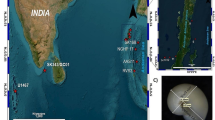Abstract
The chemical composition of zooplankton in the Kara Sea Basin has been studied. Independent samplings of the open sea and the Blagopoluchie and Tsivol’ki bays of Novaya Zemlya testify to the similarity of the distribution pattern of all the studied elements. The chemical composition of samples is predominated by organic carbon (49.5 ± 4.8% of dry weight). The other most important constituent elements are Na, P, S, K, Mg, and Ca. Their average total concentrations are 4.82 ± 0.1%. From an analysis of the composition of major and trace elements of zooplankton in the Kara Sea and the bays of Novaya Zemlya, three groups of elements have been specified: with similar (Сorg, K, S, P, Al, Ti, Sc, Cd, Se, Cs, and Rb), lower (Na, Ca, Mg, Fe, Mn, Zn, Sr, Ba, B, Cu, Pb, Cr, Ni, V, Co, Sb, Mo, Ag, Be, Ga, and Hg), and higher (Li, As, and U) contents compared to their mean concentrations in ocean zooplankton.
Similar content being viewed by others
References
V. V. Anikeev, O. V. Dudarev, A. P. Kasatkina, et al., “Influence of terrigenic and biogenic factors on formation of sedimentary fluxes of chemical elements in the coastal zone of the Sea of Japan,” Geokhimiya, No. 1, 59–72 (1996).
G. N. Baturin, Uranium in the Marine Sedimentation (Atomizdat, Moscow, 1975) [in Russian].
G. N. Baturin, E. M. Emel’yanov, and V. L. Stryuk, “Geochemistry of plankton and suspended matter in the Baltic Sea,” Okeanologiya (Moscow) 33 (1), 126–132 (1993).
V. V. Gavrilenko and V. V. Sakhonenok, Geochemistry of Rare Lithophilic Metals (Leningrad State Univ., Leningrad, 1986) [in Russian].
L. L. Demina, “Quantification of the role of organisms in the geochemical migration of trace metals in the ocean,” Geochem. Int. 53 (3), 224–240 (2015).
L. L. Demina, G. A. Leonova, V. A. Bobrov, et al., “Trace elements in plankton of the White Sea,” in The White Sea System, Ed. by A. P. Lisitzyn (Nauchnyi Mir, Moscow, 2012), Vol. 2, pp. 579–605.
A. V. Dubinin, Geochemistry of Rare Earth’s Elements in the Ocean (Nauka, Moscow, 2006) [in Russian].
N. P. Laverov, A. N. Dmitrievskii, and V. I. Bogoyavlenskii, “Fundamental aspects of oil-gas field exploration on the Russian Arctic shelf,” Arkt. Ekol. Ekon., No. 1, 26–37 (2011).
G. A. Leonova and V. A. Bobrov, Geochemical Role of Plankton from Continental Reservoirs of Siberia in Concentration and biological Sedimentation of Trace Elements (Geo, Novosibirsk, 2012) [in Russian].
G. A. Leonova, V. A. Bobrov, A. A. Bogush, and V. A. Bychinskii, “Concentration of chemical elements by zooplankton of the White Sea,” Oceanology (Engl. Transl.) 53 (1), 54–70 (2013).
A. P. Lisitzyn, “Marginal filters and biofilters of the World Ocean,” in Oceanology in the Beginning of 21st Century, Ed. by A. L. Vereshak (Nauka, Moscow, 2008), pp. 159–224.
A. P. Lisitzyn, Ocean Sedimentation (Nauka, Moscow, 1978) [in Russian].
V. A. Orlova, Analytical Autoclaves: Autoclave Preparation of Samples in Chemical Analysis (Central Scientific Research Institute of Agrochemical Service of Agriculture, Moscow, 2003) [in Russian].
V. S. Savenko, “Average elementary chemical composition of the ocean aerosol,” Dokl. Akad. Nauk SSSR 299 (2), 465–468 (1988).
V. S. Savenko, “Elementary chemical composition of ocean plankton,” Geokhimiya, No. 8, 1084–1089 (1989).
G. N. Saenko, Metals and Halogens in Marine Organisms (Nauka, Moscow, 1992) [in Russian].
N. A. Solodov, L. S. Balashov, and A. A. Kremenetskii, Geochemistry of Lithium, Rubidium, and Cesium (Nedra, Moscow, 1980) [in Russian].
D. G. Fleishman, Alkali Elements and Their Radioactive Isotopes in Aquatic Ecosystems (Nauka, Leningrad, 1982) [in Russian].
M. V. Flint, “Cruise 54th of the research vessel Akademik Mstislav Keldysh in the Kara Sea,” Oceanology (Engl. Transl.) 50 (5), 637–642 (2010).
R. J. Conover and M. Huntley, “Copepods in ice-covered seas—distribution, adaptations to seasonally limited food, metabolism, growth patterns and life cycle strategies in polar seas,” J. Mar. Syst. 2, 1–41 (1991).
A. B. Demidov, S. A. Mosharov, and P. N. Makkaveev, “Patterns of the Kara Sea primary production in autumn: Biotic and abiotic forcing of subsurface layer,” J. Mar. Syst. 132, 130–149 (2014).
J. Donnelly, J. J. Torres, T. L. Hopkins, et al., “Chemical composition of Antarctic zooplankton during austral fall and winter,” Polar Biol. 14, 171–183 (1994).
V. K. Karandashev, A. N. Turanov, T. A. Orlova, et al., “Use of the inductively coupled plasma mass spectrometry for element analysis of environmental objects,” Inorg. Mater. 44, 1491–1500 (2008).
Y. H. Li, “Distribution patterns of the elements in the ocean: a synthesis,” Geochim. Cosmochim. Acta 55, 3223–3240 (1991).
D. H. Loring, S. Dahle, K. Naes, et al., “Arsenic and other trace metals in sediments from the Kara Sea and Ob and Yenisei estuaries, Russia,” Aquat. Geochem. 4, 233–252 (1998).
J. Mauchline, The Biology of Calanoid Copepods (Academic, London, 1998).
R. S. Oremland and J. F. Stolz, “The ecology of arsenic,” Science 300, 939–944 (2003).
A. Pasternak, E. Arashkevich, M. Reigstad, et al., “Dividing mesozooplankton into upper and lower size groups: applications to the grazing impact in the Marginal Ice Zone of the Barents Sea,” Deep Sea Res., Part II 55, 2245–2256 (2008).
J. G. Sanders, “Arsenic cycling in marine systems,” Mar. Environ. Res. 3, 257–266 (1980).
M. Ventura, “Linking biochemical and elemental composition in freshwater and marine crustacean zooplankton,” Mar. Ecol.: Progr. Ser. 327, 233–246 (2006).
Zooplankton Methodology Manual, Ed. by R. P. Harris, (Academic, London, 2000).
Author information
Authors and Affiliations
Corresponding author
Additional information
Original Russian Text © N.V. Lobus, 2016, published in Okeanologiya, 2016, Vol. 56, No. 6, pp. 890–900.
Rights and permissions
About this article
Cite this article
Lobus, N.V. Elemental composition of zooplankton in the Kara Sea and the bays on the eastern side of Novaya Zemlya. Oceanology 56, 809–818 (2016). https://doi.org/10.1134/S0001437016050088
Received:
Published:
Issue Date:
DOI: https://doi.org/10.1134/S0001437016050088




